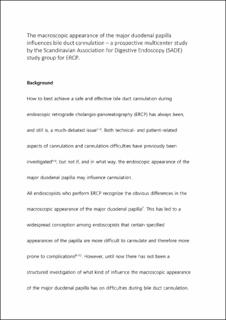| dc.contributor.author | Haraldsson, Erik | |
| dc.contributor.author | Kylanpää, Leena | |
| dc.contributor.author | Grönroos, Juha | |
| dc.contributor.author | Saarela, Arto | |
| dc.contributor.author | Toth, Ervin | |
| dc.contributor.author | Qvigstad, Gunnar | |
| dc.contributor.author | Hult, Mari | |
| dc.contributor.author | Lindström, Outi | |
| dc.contributor.author | Laine, Simo | |
| dc.contributor.author | Karjula, Heikki | |
| dc.contributor.author | Hauge, Truls | |
| dc.contributor.author | Sadik, Riadh | |
| dc.contributor.author | Arnelo, Urban | |
| dc.date.accessioned | 2022-11-29T14:10:54Z | |
| dc.date.available | 2022-11-29T14:10:54Z | |
| dc.date.created | 2019-11-28T13:17:55Z | |
| dc.date.issued | 2019 | |
| dc.identifier.citation | Gastrointestinal Endoscopy. 2019, 90 (6), 957-963. | en_US |
| dc.identifier.issn | 0016-5107 | |
| dc.identifier.uri | https://hdl.handle.net/11250/3034794 | |
| dc.description.abstract | Background and Aims: Certain appearances of the major duodenal papilla have been claimed to make cannulation more difficult during ERCP. This study uses a validated classification of the endoscopic appearance of the major duodenal papilla to determine if certain types of papilla predispose to difficult cannulation.
Methods: Patients with a naïve papilla scheduled for ERCP were included. The papilla was classified into 1 of 4 papilla types before cannulation started. Time to successful bile duct cannulation, attempts, and number of pancreatic duct passages were recorded. Difficult cannulation was defined as after 5 minutes, 5 attempts, or 2 pancreatic guidewire passages.
Results: A total of 1401 patients were included from 9 different centers in the Nordic countries. The overall frequency of difficult cannulation was 42% (95% confidence interval [CI], 39%-44%). Type 2 small papilla (52%; 95% CI, 45%-59%) and type 3 protruding or pendulous papilla (48%; 95% CI, 42%-53%) were more frequently difficult to cannulate compared with type 1 regular papilla (36%; 95% CI, 33%-40%; both P < .001). If an inexperienced endoscopist started cannulation, the frequency of failed cannulation increased from 1.9% to 6.3% ( P < .0001), even though they were replaced by a senior endoscopist after 5 minutes.
Conclusions: The endoscopic appearance of the major duodenal papilla influences bile duct cannulation. Small type 2 and protruding or pendulous type 3 papillae are more frequently difficult to cannulate. In addition, cannulation might even fail more frequently if a beginner starts cannulation. These findings should be taken into consideration when performing studies regarding bile duct cannulation and in training future generations of endoscopists. | en_US |
| dc.language.iso | eng | en_US |
| dc.publisher | Elsevier | en_US |
| dc.title | Macroscopic appearance of the major duodenal papilla influences bile duct cannulation: a prospective multicenter study by the Scandinavian Association for Digestive Endoscopy Study Group for ERCP | en_US |
| dc.type | Journal article | en_US |
| dc.description.version | submittedVersion | en_US |
| dc.rights.holder | Copyright (C) 2019 by the American Society for Gastrointestinal Endoscop | en_US |
| dc.source.pagenumber | 957-963 | en_US |
| dc.source.volume | 90 | en_US |
| dc.source.journal | Gastrointestinal Endoscopy | en_US |
| dc.source.issue | 6 | en_US |
| dc.identifier.doi | 10.1016/j.gie.2019.07.014 | |
| dc.identifier.cristin | 1753771 | |
| cristin.unitcode | 1920,15,0,0 | |
| cristin.unitname | Medisinsk klinikk | |
| cristin.ispublished | true | |
| cristin.fulltext | preprint | |
| cristin.qualitycode | 1 | |
